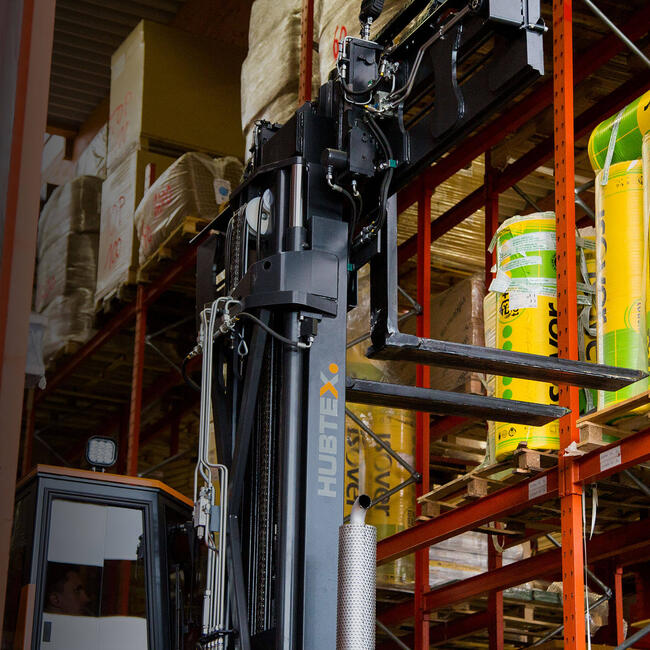New and complex requirements arise every day in intralogistics and material handling. In order to meet these requirements, forklifts and other industrial trucks must be as versatile as possible.
With the right attachment, a front loader or sideloader can soon perform an additional function. Attachments come in many different forms. They can be attached to the load carriage of the forklift or picked up with the fork.
The advantages of forklift attachments
As a rule, forklifts require a normal lift mast with two standard forks. These trucks can then be configured in a variety of ways to perform most standard applications. From time to time, however, special operations are necessary. In these situations, an attachment can transform the forklift into a multifunctional device. The various attachments expand the range of functions considerably.
The attachments can be controlled manually, mechanically, hydraulically, electrically or pneumatically. Depending on the complexity and requirements, various types of drives are available.
Generally, the addition of an attachment can considerably increase productivity and efficiency. Where a particular function is only required sporadically, attachments make sense. You can continue to use your existing trucks even more effectively. At the same time, it is often safer to carry out an application with an attachment rather than without. There is no need to compromise on safety and your employees receive the best possible protection.
Additional trucks are not required. This reduces the strain on your budget and makes even better use of your existing fleet.
Forklift attachments and safety
When using forklift attachments, you must consider various safety aspects. The truck is designed for specific applications, loads and environments to which its dimensions and performance are perfectly adapted. However, the use of attachments changes the dimensions and performance characteristics of the truck. The truck and attachment should be considered as an entirely new vehicle with new features. The truck may now be wider, longer and the load capacity may have been reduced.
How might the truck be changed?
The forklift attachments usually protrude beyond the forks. This shifts the truck's overall center of gravity forward. Depending on the attachment, the load center can also shift forward. In order to maintain the stability of the truck, the residual capacity is simultaneously reduced. This reduction in residual capacity is a result of the addition of the attachment as well as the shift in the overall center of gravity and the load center.
Attachments can weigh up to 800 kg. It is therefore very important to check the capacity of the truck.
If space is at a premium, be sure to check the dimensions of the truck with the attachment. The dimensions can change significantly depending on the type of attachment.
One factor that must never be neglected is the field of vision of the driver. Check how much the attachment restricts visibility. Where possible, safety can be further increased with camera systems or other assistance systems.
And it goes without saying that only attachments that have been tested and approved should be used.
What attachments are available for forklifts?
A brief overview of the most commonly used attachments for forklifts can be found below.
Detachable platform
Detachable platforms are used for picking goods. Depending on the design, they add considerable weight. Therefore, the truck capacity can change drastically.
Work basket / work platform
By adding a work basket, the forklift becomes a mobile lifting platform. Depending on the lift height, the operator may have to take into account significant vibrations.
Rotating devices
Adding a rotating device to your truck allows the operator to rotate the load and more easily load and deposit goods.
Fork extension
A removable fork extension or telescopic fork flexibly extends the existing forks. The manual version is ideal when usage is very limited.
Sweepers
Sweepers are picked up and then attached to the forks. They are available in a wide variety of designs for cleaning warehouses and outdoor areas.
Fork clamps
Loads can be laterally clamped and picked up using fork clamps. This attachment is particularly suitable for goods that are not stored on pallets, barrels or cable drums.
Crane hook
The crane hook or crane arm allows the load to be picked up from above. The crane arm is picked up with the forks and then protrudes significantly beyond.
Pallet turning device
The pallet turning device consists of two rows of forks. This allows a load to be picked up and rotated, which is particularly useful when changing pallets.
Snow shovel / snow blade
In winter, a forklift equipped with a snow shovel quickly turns into a snowplough. This saves valuable time and avoids the need for hiring a special service provider.
Sideshift
The sideshift allows the load to be shifted sideways. The entire fork carriage is moved to the side, becoming more flexible and manoeuverable.
Scoops
Scoops are picked up and attached to the forks. They are connected to the forklift hydraulics and function like shovels.
Fork positioner
With the fork positioner, the forks can be adjusted to different load widths. This device is particularly useful when the forklift is used in a mixed warehouse.
Gripper / pincer
A gripper works in a similar way to the fork clamps. However, grippers are specially designed for the intended application, e.g. for gripping multiple drums.
Carrying rams
Carrying rams enable the transport of goods that are wound up on rolls. The carrying rams are either picked up with the forks or attached directly to the fork carriage.

